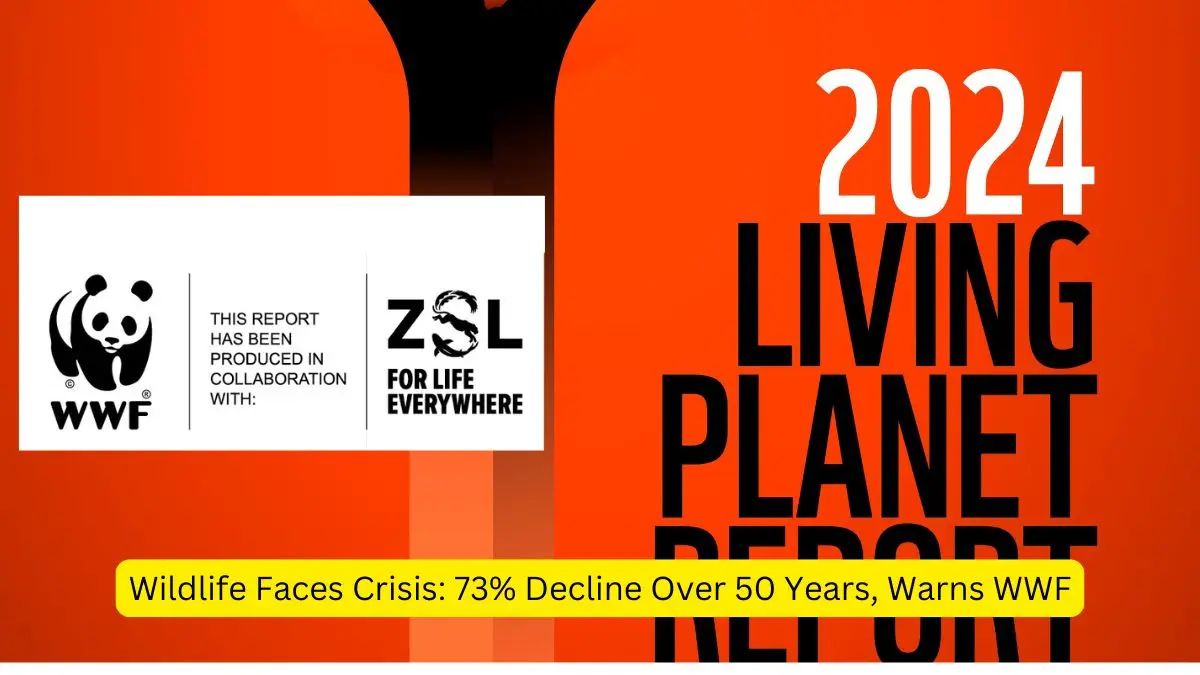Understanding WWF’s73% Wildlife Decline: Myths and Reality
Syllabus:
GS-3:
Conservation ,Environmental Pollution & Degradation ,Forest Resources ,Conservation of Resources.
Focus:
The World Wildlife Fund’s 2024 Living Planet Index (LPI) report has raised concerns with its claim of a 73% average decline in wildlife populations since 1970. Misinterpretations of the data have sparked debate, emphasising the need for accurate understanding of wildlife population trends and regional conservation needs.
Understanding the 73% Decline Figure:
- The 73% decline in WWF’s Living Planet Index (LPI) does not imply that 73% of wildlife populations are in decline, extinct, or lost.
- Instead, this figure represents an average decline across 34,836 studied wildlife populations.
- While this trend is concerning, around half of the populations studied were either stable or growing, indicating varied outcomes across species.
About World Wildlife Fund for Nature (WWF):
- Leading Conservation Role: WWF is a global leader in conservation, working in over 100 countries since its establishment in 1961, headquartered in Gland, Switzerland.
- Mission: Its mission focuses on conserving nature and reducing threats to biodiversity through innovative solutions.
- Collaboration: WWF partners globally to protect wildlife, communities, and their habitats.
- WWF-India: Established in 1969, it operates independently with offices across India and a Secretariat in New Delhi.
About Living Planet Report:
- Publication: Published biennially by the World Wide Fund for Nature (WWF).
- Focus: Provides a comprehensive analysis of global biodiversity trends and planetary health.
- 2024 Edition: The 15th edition of this report.
- Living Planet Index (LPI): Tracks average trends in wildlife populations rather than individual species changes.
- Purpose: Acts as an early extinction risk warning and assesses ecosystem efficiency by monitoring species population trends over time.
Evolution of LPI Data and Changes in Methodology:
- The 2024 LPI report is not a straightforward update from 2022; the trend shift is due to increased data and updated methodologies.
- Approximately 3,000 additional populations and 250 more species were analysed in the latest LPI, leading to an overall trend shift rather than a continuous decline.
- Only native species are now included in the LPI, whereas previous reports included both native and non-native species. This change accounts for some shifts, especially in regions like Europe and Central Asia.
Regional Variations and Contributing Factors:
- Different regions show varied trends. For example, Africa’s LPI dropped due to a 45% increase in studied populations, many of which are in decline.
- Excluding non-native species caused fewer populations to be counted in Europe and Central Asia, shifting the trend for these regions.
- These regional adjustments highlight that the inclusion or exclusion of certain species significantly affects the LPI’s overall trajectory.
Distribution of Population Trends Across Taxonomic Groups:
- Half of the populations in the LPI were declining, 43% were increasing, and 7% remained stable, showing mixed results rather than a universal decline.
- When analysed by taxonomic groups (mammals, birds, fish, reptiles), there are populations with positive trends, indicating resilience in certain groups.
- The report encourages focusing resources on populations facing severe threats, making conservation efforts more targeted and effective.
Strategic Conservation and Resource Allocation:
- While the decline is worrying, the findings suggest that directing resources toward critically declining populations may be more effective.
- Conservation strategies can prioritise specific populations or regions with the most severe declines, improving restoration success rates.
- The 2024 LPI report, while concerning, underscores that not all wildlife populations are in crisis, emphasising the importance of precise and focused conservation action.
Addressing Misinterpretations and Raising Awareness:
- Misinterpretations often lead to panic; clarifying the data prevents misinformation around extinction and wildlife health.
- The LPI report is a call to action but also a reminder that some wildlife populations are thriving, reflecting mixed but hopeful global trends.
- This balanced understanding encourages the public and policymakers to view conservation challenges through an informed lens, guiding better decision-making.
Challenges:
- Data Misinterpretation: Public misunderstandings of statistics, like the 73% decline in wildlife, can lead to misinformation and misplaced panic, diverting focus from specific conservation needs.
- Regional Disparities: Wildlife trends vary widely by region, complicating universal conservation strategies and requiring localised, context-specific approaches.
- Biodiversity Loss: Habitat destruction, climate change, and pollution accelerate biodiversity loss, placing unprecedented pressure on ecosystems worldwide.
- Resource Allocation: Limited funding and resources can make it difficult to address all threatened populations, necessitating prioritisation that may overlook some struggling species.
- Methodological Updates: Shifting data sets and inclusion criteria make it challenging to track consistent wildlife trends over time, impacting long-term conservation planning.
- Policy Gaps: Inadequate policy support and enforcement in many regions hinder effective wildlife protection, especially in high-risk areas.
Way Forward:
- Data Transparency: Promoting clear communication on wildlife statistics will help mitigate misinterpretations and foster public understanding.
- Localised Conservation: Regional strategies tailored to specific ecosystem needs can address unique challenges and support biodiversity effectively.
- Strengthened Policies: Stronger legislative frameworks and enforcement can better protect critical habitats and at-risk species.
- Public Awareness: Educating the public about actual conservation needs ensures support for prioritised actions and sustainable practices.
- Resource Prioritisation: Allocating resources efficiently to high-risk populations will optimise conservation efforts where they’re most needed.
- Collaborative Efforts: Engaging stakeholders, governments, and conservation groups can amplify impact and secure funding for long-term biodiversity protection.
Conclusion:
The LPI report’s findings underscore the urgency of targeted conservation efforts rather than generalised panic. Correctly interpreting data can direct resources to endangered populations and regions most at risk, thereby enhancing global biodiversity conservation strategies and promoting informed public engagement.
Source: TH
Mains Practice Question:
“Discuss the implications of the WWF’s Living Planet Index report on wildlife conservation strategies in India. Highlight the importance of accurate data interpretation in biodiversity policy.” (250 words)




